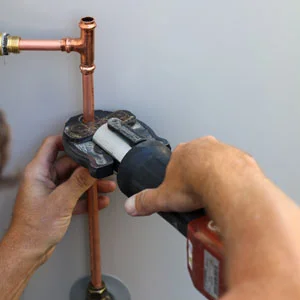6 Emergency Plumbing Fixes Every Homeowner Must Learn
Plumbing is that part of your home which is in use 24×7. Any repair to a plumbing system could halt your whole day. However, calling a professional plumber for every minor repair is difficult. For this exact reason, homeowners nowadays are keen to learn some useful plumbing fixes so they don’t need to depend on someone else all the time.
Nevertheless, one should know what can and can’t be done with quick fixes. Sometimes, trying to fix a problem yourself could worsen the situation. Hence, try your hand only at minor adjustments and repairs. Anything beyond minor is best left to a professional.
Here’s a listicle that illustrates 6 plumbing hacks you must learn to be self-sufficient.
1. Memorizing Your Shut-Off Valve Location
Every homeowner must know where the shut-off valve is located in their home. Say, you have an emergency pipe burst in your bathroom, but you don’t know how to stop the flooding. What should you do?
Shut off the main water source, of course.
This simple tip could save your home from getting soggy in a plumbing situation. Not to mention the cleaning afterwards, water damage, and even mold issues are a headache.
Hence, know where your emergency shut-off valve lies in your home. Perhaps, you can ask your plumber in Geelong to point at it.
2. Eliminate the Clogs
No such home where it hasn’t seen a clog. It could be in pipes, drains, disposal, or toilets. That is why it is rather helpful to learn how to unclog.
You can use a drain snake or a plunger, for a simple clog cleaning. You can use these tools to clear a clog without help from a professional plumber. They are also easy to handle.
On the other hand, you may also try some homemade solutions. Try mixing vinegar and baking soda. Then pour it down the drain and later flush it with hot water. It’s a wonderful trick to clear clogs.
If these don’t do the trick, the clog might be deeper, so you should call a 24×7 emergency plumber in Geelong.
A tip—do not go for chemical cleaners straight away as they can damage the pipes. Chemical solutions should always be a last resort.
3. Tightening the Pipes
Over time, the threads on your pipes become loose and might cause minor leaks. As the homeowner, you must ensure these are immediately fixed— before they become big leaks. You may include this in your routine plumbing maintenance, or you can do something yourself.
To make a simple DIY pipe tightener:
- Cut the water off.
- Screw the dripping pipes open.
- Wrap one layer of masking tape around the pipe’s threads.
- Reconnect the pipes using screws.
It’s that simple!
However, if you are not confident enough to do it, don’t bother. Give your plumber in Geelong a call, and they will tend to it.
4. Dripping Faucets
Leaking faucets are an age-old plumbing nightmare. Even though a leaky faucet is one of the most bothersome household issues, we frequently let it fall to the bottom of our to-do lists.
Follow this:
- Put a washcloth and a rubber band around the faucet to halt the continuous drip-drip-drip. If the leak is significant, you may also need to place a bucket below.
- When you are ready to address the problem directly, cut off the water and remove the tap body.
- Replace the washer or O-ring, and reinstall.
Problem resolved!
5. Locating Invisible Leaks
You might have received a monstrous water bill at the month’s end or seen mold, water damage, and low water pressure. It could be a leak, but how can you be certain?
It might be challenging to locate an invisible leak, but it is not impossible!
Take a reading from the water meter after closing all the faucets. Ensure nobody has used water for a few hours, and recheck the metre. If it still indicates water use, you most probably have a leak and should contact the experts.
Another typical location for leaks is the bathroom. Try painting the inside of the tank using food coloring. After 30 minutes, if there is color in the toilet bowl, the tank is leaking.
With these two methods, you can certainly determine if there is a leak.
6. Maintaining Garbage Disposal
Garbage disposal is another system we use frequently in our homes. Misunderstanding its name, most people treat a garbage disposal like a dust bin— thus, needing frequent emergency plumbing in Geelong. However, even your garbage expects some maintenance and care.
You can avoid repairs and clogs by properly understanding how to use your garbage disposal. For starters, do not put the following items into your garbage disposal.
- Fibrous foods— celery, asparagus, or sprouts
- Grease, oils, and fats
- Eggshells
- Espresso grounds
- Bones
- Starchy foods— spaghetti, beans, peels, or rice
- Non-food items
After filtering the waste out this way, your garbage disposal will work for much longer than otherwise.
Further, you can also try a hack to maintain the sharpness of your disposal blades and eliminate strange odors.
- Throw a few ice cubes and a piece of lemon peel into the garbage disposal every so often.
- Run it for about 30 seconds without water, then with a little dish soap and some water.
In less than a minute, you will have razor-sharp blades and a lemony fragrance.
Conclusion
After all these hacks and maintenance, you will still face some plumbing problems that only a professional can handle. Thus, keep your Geelong plumber’s contact available. Scheduling regular plumbing maintenance with an expert is also a good idea.
Your Local Plumbing has a great track record in everything related to plumbing. Give them a chance if you are looking for reliable plumbing professionals.
